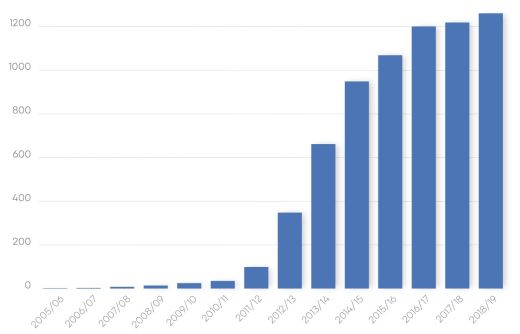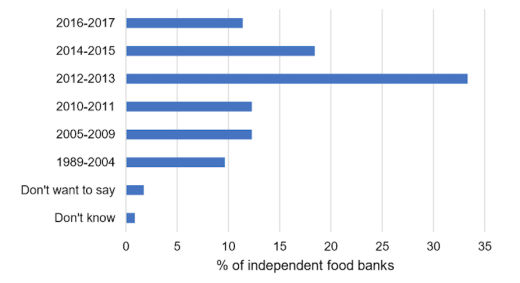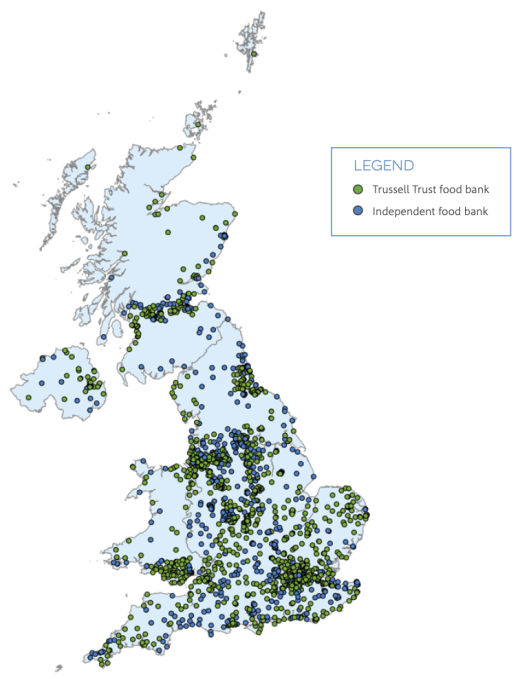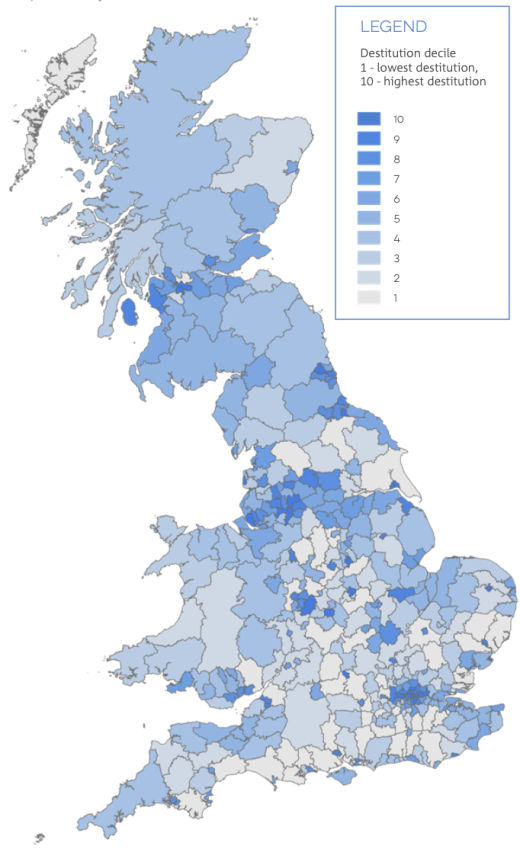Lizzie Peck provides an overview of the emergence and rapid growth of food banks since the Coalition Government and the combination of austerity and welfare reform.
Author: Lizzie Peck
Food banks were never a normal part of life in Britain. The post-1945 welfare state had eradicated the need for people to go pleading for food in order to feed their children. Yet, following Coalition Government of 2010 and the subsequent Conservative Governments food banks have grown as Government policy has hammered the poorest. Even people in work are finding themselves forced to go to food banks. In this short article Lizzie Peck provides a powerful and useful summary of some of the key data.
With the 2019 general election upon us, it seems necessary to report on a subject which affects so many people: food bank usage in the UK. The Trussell Trust alone gave out a record 1.6 million 3 day emergency food bank parcels in the 2018-2019 financial year (Trussell Trust, 2019a). The Independent Food Aid Network and A Menu for Change collated data in Scotland which revealed that data from independent food banks almost doubled previously known Trussell Trust figures (IFAN, March 2019).
The Independent Food Aid network, who have mapped independent food banks across the UK, categorise a food bank as ‘a venue which regularly gives out emergency food parcels at least once a week’ (Goodwin, 2019).
The issue is complicated by the fact that the UK does not have one system or organisation that runs food banks. Instead, there is the Trussell Trust, which runs the majority, at over 1200 centres (Trussell Trust, 2019). There are then at least 819 independent food banks which Sabine Goodwin of the Independent Food Aid Network has mapped, taking the total to at least 2000 food banks. However she also estimates that there at least 3000 extra ‘non-food bank independent food aid providers’ which makes at least 5000 venues are distributing food aid to people in need (Goodwin, 2019).
The Trussell Trust has documented the number of their own food banks which are in operation each year and their data shows a sharp increase in the number operating across the UK, from almost none in 2005-2006, to over 1200 in 2018-2019 (Sosenko et al. 2019).

Figure 1 Growth in Trussell Trust food banks
An independent food bank study (Loopstra et al. 2019) which looked at a random sample of independent food banks (total 114) found that although almost 10% began distributing food parcels before 2004, the majority were set up in the last 9 years. This is consistent with the pattern in the number of Trussell Trust food banks opening each year (a sharp rise after 2010). See Figure 2.

Figure 2 Year food bank started distributing parcels (n = 114)
As it says in the ‘State of Hunger’ report, food bank usage has a strong link to areas suffering greater “with a strong emphasis on former industrial urban areas in the North and Midlands, some coastal towns and a range of London boroughs” (Sosenko et al. 2019).

Figure 3 Location of UK food banks 2019

Figure 4 Distribution of destitution in the UK
The two maps from the State of Hunger report challenge the common thinking that people use food banks simply because of their availability. The report finds quite clearly (and this is what the maps show) that there is a strong link between destitution and food bank usage: where a local authority has a high level of deprivation, this has meant that food banks have had to open to meet a need.
Worryingly, these figures are probably the tip of the iceberg of food poverty because some food banks require a referral from a professional and there is a limit on the number of referrals an individual can have, so many people will be slipping under the radar and not getting the help they need (Loopstra et al. 2019). Also, perhaps 2% of UK households used a food bank between April 2018 and March 2019 but 10% live with moderate and severe food insecurity, even if not attending a food bank (Sosenko et al. 2019 and Loopstra et al. 2019).
How has this become acceptable in a wealthy society which should have no problem in providing all that people need to thrive?
Butler P (2017) Report reveals scale of food bank use in the UK. The Guardian: 29th May 2017
Food Aid Network (2019) http://www.foodaidnetwork.org.uk/independent-food-banks-map (accessed 10/12/19)
Goodwin S (2019) Mapping the UK's independent food banks Independent Food Aid Network http://www.foodaidnetwork.org.uk/independent-food-banks-map (accessed 09/12/19)
Independent Food Aid Network and A Menu for Change (2019) Emergency Food Parcel Provision in Scotland April 2018 to September 2019
Loopstra R, Goodwin S, Goldberg B, Lambie-Mumford H, May J, Williams A. A survey of food banks operating independently of the Trussell Trust food bank network, 2019. Available from http://www.foodaidnetwork.org.uk/ (accessed 17/02/2020)
Sosenko F, Littlewood M, Bramley G, Fitzpatrick S, Blenkinsopp J & Wood J (2019) State of Hunger: A study of poverty and food insecurity in the UK. Salisbury: The Trusell Trust.
Trussell Trust (2019a) https://www.trusselltrust.org/news-and-blog/latest-stats/end-year-stats/ (accessed 10/12/19)
Trussell Trust (2019b) https://www.trusselltrust.org/what-we-do/ (accessed 09/12/19)
The publisher is the Centre for Welfare Reform.
UK Food Banks in 2019 © Lizzie Peck 2019.
All Rights Reserved. No part of this paper may be reproduced in any form without permission from the publisher except for the quotation of brief passages in reviews.
social justice, tax and benefits, England, Northern Ireland, Scotland, Wales, Article